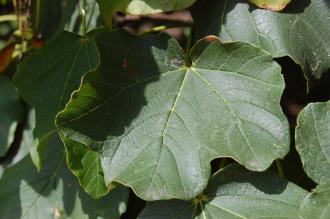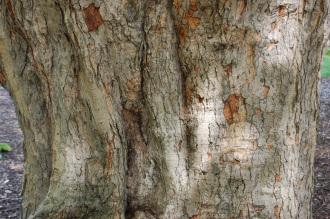
Acer opalus subsp. obtusatum (15/08/2015, Kew Gardens, London)
Position: Full sun to partial shade
Flowering period: Mid spring to early summer
Soil: Moist, well drained
Eventual Height: 20m
Eventual Spread: 20m
Hardiness: 5a, 5b, 6a, 6b, 7a, 7b, 8a, 8b, 9a
Family: Sapindaceae
Acer opalus subsp. obtusatum is a medium sized deciduous tree with a rounded habit. Its mid green glossy leaves are palmate with 5 shallow lobes and sinuate margins, up to 13cm long and 16cm across. Its leaves turn pink/ yellow before they fall in autumn. Its bark is grey/ brown and plated, becoming deeply fissured with age. Its green/ yellow flowers are small, hang down in bunches and appear before its leaves. Its fruit is a pair of winged samara which are up to 3.5cm long.

Acer opalus subsp. obtusatum Leaf (15/08/2015, Kew Gardens, London)
Acer opalus subsp. obtusatum, commonly known as the Bosnian Maple, is native to south east Europe, including Italy. Acer opalus subsp. obtusatum is synonymous with Acer obtusatum.
The etymological root of the binomial name Acer is from the Latin meaning ‘sharp’, in reference to the classical roman use of the genus to make spears. Opalus is derived from the Latin opulus, meaning ‘unripe’. Obtusatum is derived from the Latin obtusus meaning ‘to blunt’
The landscape architect may find Acer opalus subsp. obtusatum useful as an attractive parkland tree, with its early flowers and attractive autumn leaf color.

Acer opalus subsp. obtusatum Bark (15/08/2015, Kew Gardens, London)
Ecologically, Acer opalus subsp. obtusatum seeds are attractive to some mammals and birds.
Acer opalus subsp. obtusatum prefers moist, fertile, well-drained soils. It tolerates most pH of soil. It will not tolerate drought conditions.
Acer opalus subsp. obtusatum requires little maintenance.

Landscape Architecture

